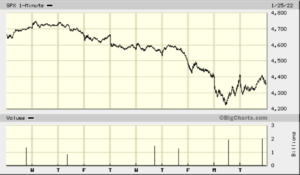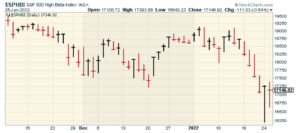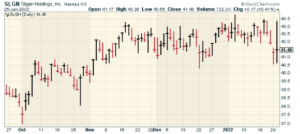CWS Market Review – January 25, 2022
(This is the free version of CWS Market Review. If you like what you see, then please sign up for the premium newsletter for $20 per month or $200 for the whole year. If you sign up today, you can see our two reports, “Your Handy Guide to Stock Orders” and “How Not to Get Screwed on Your Mortgage.”)
It’s Turnaround Week on Wall Street
There seems to be a theme this week of big stock market comebacks. The market was down big during the day on Monday, and we eventually closed higher. To a lesser extent, it happened again today. We turned a mid-day loss of nearly 2.8% into an eventual loss of 1.22%.
What’s going on? Well, the stock market has obviously gotten very jittery of late. Wall Street is reacting to threats from all sides. At the top of the list is fear of an imminent Russian invasion of Ukraine, but that’s not all. Inflation continues to be at multi-decade highs. Jobless claims are creeping higher. Plus, there’s another Federal Reserve meeting this week. The first interest rate increase in more than three years may only be a few weeks away.
All of this has unnerved traders. Yesterday, the stock market had one of its most dramatic intra-day reversals in recent market history. At one point, the S&P 500 was down 4% during the day (well, 3.99% to be precise). At 12:25 p.m. ET everything suddenly changed, and stocks started a furious rally. We managed to close higher for the day.
Here’s a remarkable stat: If it wasn’t for Monday’s late-day rally, then the S&P 500 was on pace for its worst 16-day start to a new year on record (that’s more than 90 years.)
Here’s the minute-by-minute chart of the S&P 500 for the last two weeks:

For some broader context, Ryan Detrick noted that since 1950, the market has lost 4% during the day 88 times, but yesterday was only the third time that the market closed higher. The other two times came in 2008.
The Nasdaq was even more extreme. At one point yesterday, the Nasdaq Composite was off 4.90%, and it closed higher by 0.63%. This came on top of the Nasdaq’s losing run over the past few weeks. From its all-time intra-day high to yesterday’s low, the Nasdaq Composite lost 19.16%.
Momentum has clearly shifted in favor of the bears. On Friday, the S&P 500 closed below its 200-day moving average for the first time in more than 18 months. On a closing basis, the stock market reached its high on January 3. The recent low was on Friday, January 21. Over that time, the S&P 500 fell 8.31%. That’s getting close to a 10% drop which is the traditional definition of a market correction.
Corrections aren’t that rare. There have been 32 in the last 42 years. Investors need to understand that these rough patches come along every so often. In fact, history has shown that lousy markets are very good times to buy. One year after a correction’s end, the stock market has gained an average of 25%. Of course, the hard part is that we never know exactly when the corrections will end.
There’s an old saying on Wall Street that bulls go up the stairs while bears jump out the window. That’s certainly true. Stock rallies tend to be long and slow while bear markets are sharp and fast. (Remember the extreme market we had during March 2020.) Every day seems more and more frenetic. We’ve already had six daily losses this year of more than 1%. At the same time last year, it had only happened once.
Yesterday’s initial selling was heavily concentrated among those risky, highly-volatile sectors that I’ve talked so much about. Those are precisely the stocks that bounced back so strongly. Callie Cox picked up this great stat. The 100 worst-performing Russell 3000 stocks so far this year (through Friday) rose an average of 3.8% on Monday.
Just to give you one example, yesterday shares of Shopify (SHOP) fell more than 11%. By the closing bell, the stock had gained 6.4% higher. From top to bottom, Shopify gained over 23%. That occurred over a span of roughly 90 minutes. (The market’s recent behavior seems to be mirroring the dramatic playoff football games we saw this weekend.)
On our Buy List, Trex (TREX) is having a very tough year so far after having great years in 2020 and 2021, and it also closed higher yesterday by just over 2%, but it was down again today. At its low, the S&P 500 High Beta index was down 5.09% on Monday. It closed higher by 1.08%. The S&P 500 Low Vol index closed down by 0.17%.
Here’s a daily chart of the S&P 500 High Beta Index. Notice how the daily crosses have grown longer and longer. That indicates the daily spread between the high and the low.

Today was another big comeback for the market, but not as much as yesterday was. Not long after today’s open, the S&P 500 was sitting on a loss of 2.79%. Then the bulls came out, and we finished the day with a loss of 1.22%.
The difference is that today’s market was also much broader than what we saw yesterday. By this, I mean that we didn’t see those big gaps between different sectors like growth and value. Today, the High Beta Index lost 0.64% while the Low Vol Index was down 0.82%. That’s not such a big spread, especially compared with recent days.
The major theme is that all these formerly popular stocks are getting punished. A number of the famous “meme stocks” from a year ago have been crushed in recent days. Both AMC (AMC) and GameStop (GME) are down over 60% in the last few weeks. A year ago, Peloton (PTON) was going for $171 per share. Lately, it’s been as low as $23.
This is even impacting the crypto world. Bitcoin recently fell to around $33,000. That’s down nearly half since November. Although, Bitcoin moves so quickly, I wouldn’t be surprised if it made all that back in a few days.
Why is all this happening? That’s hard to say. You can never easily divine the markets’ intentions. I would say that the war talk has spooked the markets. This has also drawn more attention to concerns about valuations and what the Fed has planned.
Of course, that’s not really new information. After ignoring the Fed for so long, perhaps traders are finally realizing that the cost-free world will soon end.
Kohl’s Soared on Buyout Offer
Shares of Kohl’s (KSS), the department store, soared 36% yesterday after the company got a buyout offer of $64 per share. On Friday, Kohl’s had closed at $46.84 per share.
The offer was made by Starboard Value, an activist investor, in tandem with a consortium of other investors. Activist investors don’t merely invest in a company; they also push for big changes in the company’s strategy.
What makes the Kohl’s story interesting is that this may have started a bidding war. Sycamore Partners said it’s willing to pay $65 for Kohl’s. So far, Kohl’s is keeping quiet which is the smart thing to do.
Honestly, Kohl’s business hasn’t been doing very well. The stock has underperformed the market for nearly 20 years. The department store wasn’t doing well going into Covid and the pandemic really put the squeeze on them. The stock lost two-thirds of its value in less than one month.
Last year, Kohl’s lost $2.36 per share. This year, it’s on track to make about $7.25 per share although the Q4 earnings won’t be out until early March. By conventional metrics, that makes KSS look like a cheap stock, but I’m skeptical.
Kohl’s isn’t a stranger to activist investors. Before these offers, Macellum, an activist shop, pushed for changes and got some board seats. The relations have not been smooth. The investors said that Kohl’s spent another year “materially mismanaging the business.” It’s hard to disagree.
A major source of contention is that Kohl’s owns a ton of real estate. The activists want to see the company sell that off and use the proceeds to buy back its stock. That would probably give the share price a big boost. Cowen said that Kohl’s is worth $75 or more. Macellum thinks KSS could go for $100 per share.
It’s true that Kohl’s is going for a cheap valuation. It’s also true that there’s some value to be unlocked, but I don’t see a long-run strategy for Kohl’s. Buying a mediocre business and waiting for it to revert to some idea of “fair value” is a tough strategy. I’d much rather own a high-quality company even if I’m paying extra.
I wish Kohl’s well, but I’m avoiding this stock.
Strong Earnings from Silgan
Silgan Holdings (SLGN) led off our Q4 earnings season after the close today. The container company had a very good quarter. For Q4, Silgan made 79 cents per share. Wall Street had been expecting 73 cents per share. Three months ago, the company said that Q4 earnings would be between 69 to 79 cents per share.

For the year, Silgan made $3.40 per share. That’s up 11% from 2020. Sales were up 17.3%. Silgan had record free cash flow of $466.1 million. Best of all, the company expects another good year for 2020.
Adam Greenlee, the president and CEO, said:
“Looking forward to 2022, we expect further improvements in the supply chain and labor issues as well as a more stable resin environment. In addition, our teams are diligently working towards the successful integration of the three acquisitions completed in 2021, which are expected to provide additional significant earnings growth in 2022. Therefore, we estimate adjusted earnings per share in 2022 in the range of $3.80 to $4.00, which represents a 15 percent increase at the midpoint over record 2021 levels. Our free cash flow estimate for 2022 is estimated at approximately $350 million, as we anticipate an increase in working capital primarily related to significant metal inflation in 2022, increased capital expenditures for growth investment opportunities with core customers and higher cash taxes which will more than offset strong earnings growth.”
Wall Street had been expecting $3.73 per share for this year. For Q1, Silgan expects earnings to range between 70 cents and 80 cents per share. This means Silgan is going for about 10 times next year’s earnings. Silgan remains an excellent buy.
That’s all for now. I’ll have more for you in the next issue of CWS Market Review.
– Eddy
P.S. Don’t forget to sign up for our premium newsletter.
Posted by Eddy Elfenbein on January 25th, 2022 at 7:25 pm
The information in this blog post represents my own opinions and does not contain a recommendation for any particular security or investment. I or my affiliates may hold positions or other interests in securities mentioned in the Blog, please see my Disclaimer page for my full disclaimer.
- Tweets by @EddyElfenbein
-
-
Archives
- May 2024
- April 2024
- March 2024
- February 2024
- January 2024
- December 2023
- November 2023
- October 2023
- September 2023
- August 2023
- July 2023
- June 2023
- May 2023
- April 2023
- March 2023
- February 2023
- January 2023
- December 2022
- November 2022
- October 2022
- September 2022
- August 2022
- July 2022
- June 2022
- May 2022
- April 2022
- March 2022
- February 2022
- January 2022
- December 2021
- November 2021
- October 2021
- September 2021
- August 2021
- July 2021
- June 2021
- May 2021
- April 2021
- March 2021
- February 2021
- January 2021
- December 2020
- November 2020
- October 2020
- September 2020
- August 2020
- July 2020
- June 2020
- May 2020
- April 2020
- March 2020
- February 2020
- January 2020
- December 2019
- November 2019
- October 2019
- September 2019
- August 2019
- July 2019
- June 2019
- May 2019
- April 2019
- March 2019
- February 2019
- January 2019
- December 2018
- November 2018
- October 2018
- September 2018
- August 2018
- July 2018
- June 2018
- May 2018
- April 2018
- March 2018
- February 2018
- January 2018
- December 2017
- November 2017
- October 2017
- September 2017
- August 2017
- July 2017
- June 2017
- May 2017
- April 2017
- March 2017
- February 2017
- January 2017
- December 2016
- November 2016
- October 2016
- September 2016
- August 2016
- July 2016
- June 2016
- May 2016
- April 2016
- March 2016
- February 2016
- January 2016
- December 2015
- November 2015
- October 2015
- September 2015
- August 2015
- July 2015
- June 2015
- May 2015
- April 2015
- March 2015
- February 2015
- January 2015
- December 2014
- November 2014
- October 2014
- September 2014
- August 2014
- July 2014
- June 2014
- May 2014
- April 2014
- March 2014
- February 2014
- January 2014
- December 2013
- November 2013
- October 2013
- September 2013
- August 2013
- July 2013
- June 2013
- May 2013
- April 2013
- March 2013
- February 2013
- January 2013
- December 2012
- November 2012
- October 2012
- September 2012
- August 2012
- July 2012
- June 2012
- May 2012
- April 2012
- March 2012
- February 2012
- January 2012
- December 2011
- November 2011
- October 2011
- September 2011
- August 2011
- July 2011
- June 2011
- May 2011
- April 2011
- March 2011
- February 2011
- January 2011
- December 2010
- November 2010
- October 2010
- September 2010
- August 2010
- July 2010
- June 2010
- May 2010
- April 2010
- March 2010
- February 2010
- January 2010
- December 2009
- November 2009
- October 2009
- September 2009
- August 2009
- July 2009
- June 2009
- May 2009
- April 2009
- March 2009
- February 2009
- January 2009
- December 2008
- November 2008
- October 2008
- September 2008
- August 2008
- July 2008
- June 2008
- May 2008
- April 2008
- March 2008
- February 2008
- January 2008
- December 2007
- November 2007
- October 2007
- September 2007
- August 2007
- July 2007
- June 2007
- May 2007
- April 2007
- March 2007
- February 2007
- January 2007
- December 2006
- November 2006
- October 2006
- September 2006
- August 2006
- July 2006
- June 2006
- May 2006
- April 2006
- March 2006
- February 2006
- January 2006
- December 2005
- November 2005
- October 2005
- September 2005
- August 2005
- July 2005
 Eddy Elfenbein is a Washington, DC-based speaker, portfolio manager and editor of the blog Crossing Wall Street. His
Eddy Elfenbein is a Washington, DC-based speaker, portfolio manager and editor of the blog Crossing Wall Street. His